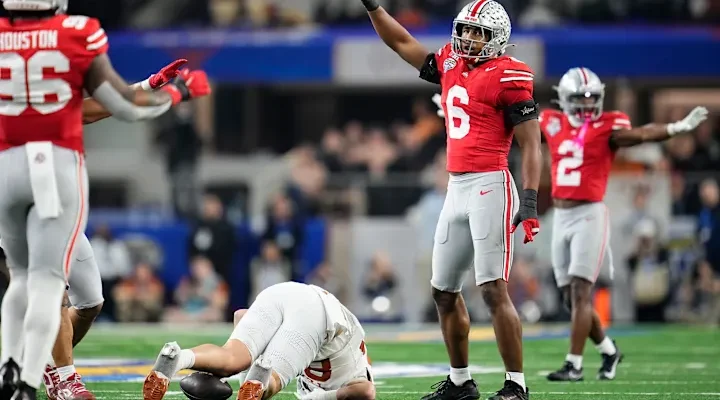Ohio State Football’s Remarkable Consistency: Why the Buckeyes Have Avoided the Historical Low Points That Hit Texas, Michigan, Alabama, and Oklahoma
In the long and storied history of college football, even the greatest programs have endured periods of mediocrity—or worse. Texas, Michigan, Alabama, and Oklahoma, all considered blue-blood programs, have each faced eras where their dominance faded, seasons slipped into disappointment, and fan morale was tested. Yet there is one powerhouse that has remarkably avoided such prolonged downturns: Ohio State. The Buckeyes have maintained a level of consistency that is unmatched in the sport, never experiencing the kind of deep low points that have temporarily derailed other national giants.
From the early days of the program to the modern College Football Playoff era, Ohio State’s trajectory has been one of steady competitiveness, elite recruiting, and championship aspirations. While other schools have endured multi-year stretches of mediocrity—Texas stumbling through the post-Mack Brown years, Michigan languishing in the Rich Rodriguez and Brady Hoke eras, Alabama floundering before Nick Saban’s arrival, and Oklahoma navigating post-Switzer inconsistency—the Buckeyes have managed to keep themselves firmly in the national spotlight without interruption. Even in their “down” years, Ohio State has remained a legitimate threat on the national stage.
One of the key reasons behind this sustained success is the program’s ability to transition between head coaches without catastrophic drop-offs. From Woody Hayes to Earle Bruce, John Cooper to Jim Tressel, Urban Meyer to Ryan Day, Ohio State has always found leaders capable of maintaining high standards. There has never been an extended period where the program lacked direction or identity. This stands in sharp contrast to other blue-blood programs that, after losing a legendary coach, struggled to find the right successor and saw their on-field results suffer.
Recruiting consistency has also been central to Ohio State’s ability to avoid historical slumps. The Buckeyes have never had a recruiting class fall far below national standards, and they have consistently attracted top-tier talent from across the country while keeping the best players in Ohio at home. Even in transitional years, Ohio State’s rosters have been loaded with future NFL players, allowing them to compete with and beat other top programs. When other schools saw recruiting drop off during coaching changes or losing seasons, Ohio State remained a magnet for elite athletes.
Another factor is the strength and size of the Ohio State fan base. Buckeye Nation is one of the most passionate and loyal followings in sports, and that loyalty translates into financial support, packed stadiums, and national visibility regardless of the team’s record. This unwavering backing creates an environment that is attractive to both recruits and coaches, making it much easier for the program to rebound quickly from setbacks. At Texas, Michigan, and other blue-blood programs, fan patience sometimes wore thin during extended slumps, adding pressure and instability. Ohio State has never had to weather that kind of crisis because they have never given fans a reason to abandon hope.
Perhaps the most underrated reason for Ohio State’s steadiness is the institutional commitment to excellence in football. The program has always been well-funded, with top-tier facilities, large support staffs, and a willingness to invest in whatever is needed to compete at the highest level. While other programs have gone through periods of administrative misalignment or budgetary hesitation, Ohio State’s leadership has maintained football as a top priority. That unwavering support has insulated the program from the type of neglect that can lead to long-term decline.
Even the Buckeyes’ “lowest” points in recent memory would be considered enviable seasons for most programs. A two-loss season without a Big Ten title? That’s a crisis in Columbus, yet for many schools it would be celebrated as a resounding success. The program’s floor has been so high for so long that there is no true equivalent to the stretches that saw Texas finish with losing records, Michigan sink below .500, or Alabama go a decade without a national title.
Part of this resilience is cultural. Ohio State’s internal expectations are relentless, and anything short of conference championships and playoff contention is seen as underachievement. That pressure doesn’t crush the program—it fuels it. Coaches and players know that they are held to one of the highest standards in sports, and the culture has been built to embrace those demands. This creates a self-sustaining cycle where excellence is the norm and anything less is swiftly addressed.
The Buckeyes’ rivalry with Michigan has also played a role in maintaining their competitive edge. The constant need to prepare for “The Game” has served as a yearly benchmark for success, keeping focus sharp and complacency at bay. Even in years when the Wolverines were struggling, the tradition and stakes of the matchup ensured Ohio State stayed locked in. For other programs without such a consistent measuring stick, it’s easier to drift into prolonged slumps.
Looking at the broader picture, Ohio State’s ability to avoid historical low points is a combination of leadership stability, elite recruiting, unwavering fan support, institutional commitment, and a culture of high expectations. In every era, they have found ways to adapt to changes in the sport, from scholarship limits to NIL to the transfer portal, without losing their identity or slipping from the top tier.
While no program is truly immune to challenges, Ohio State’s track record suggests they are as close to slump-proof as any team in college football history. They have set the gold standard for sustained excellence, proving that with the right structure, culture, and commitment, it’s possible to avoid the pitfalls that have humbled even the most storied programs. For Texas, Michigan, Alabama, and Oklahoma, history includes stretches they would rather forget. For Ohio State, the story is different—there are no dark ages, only varying shades of success.



